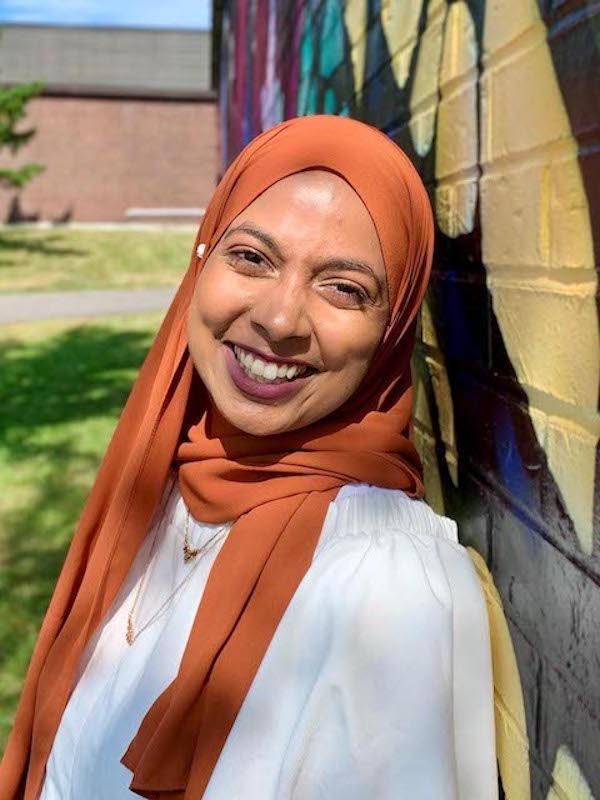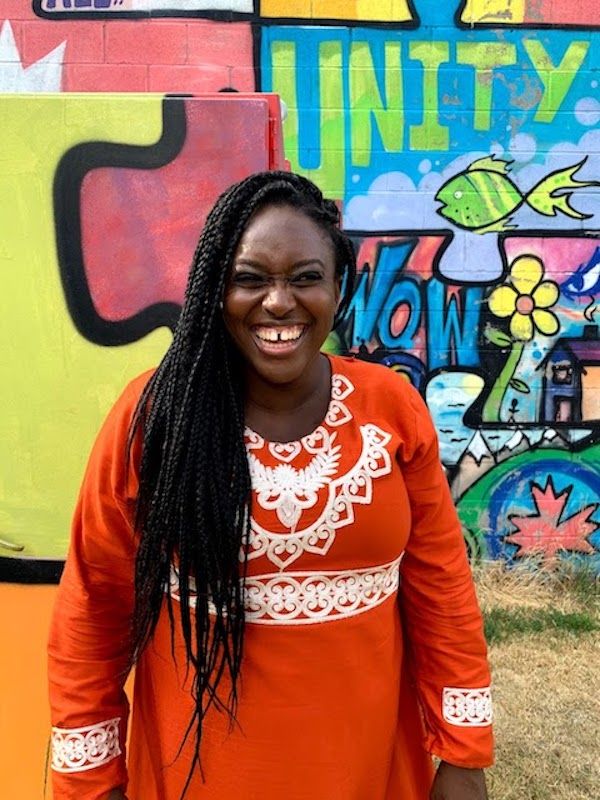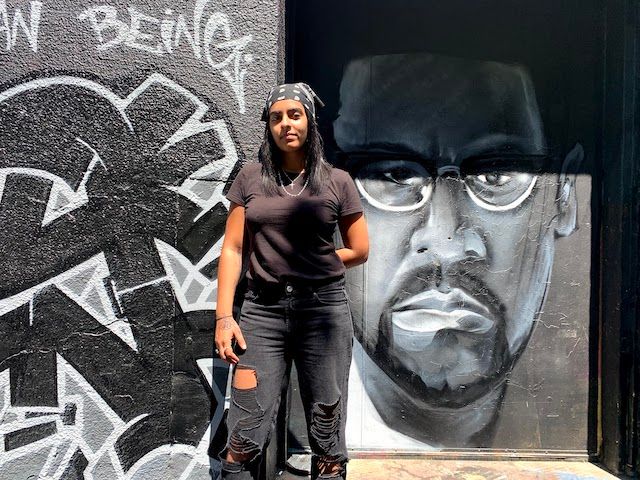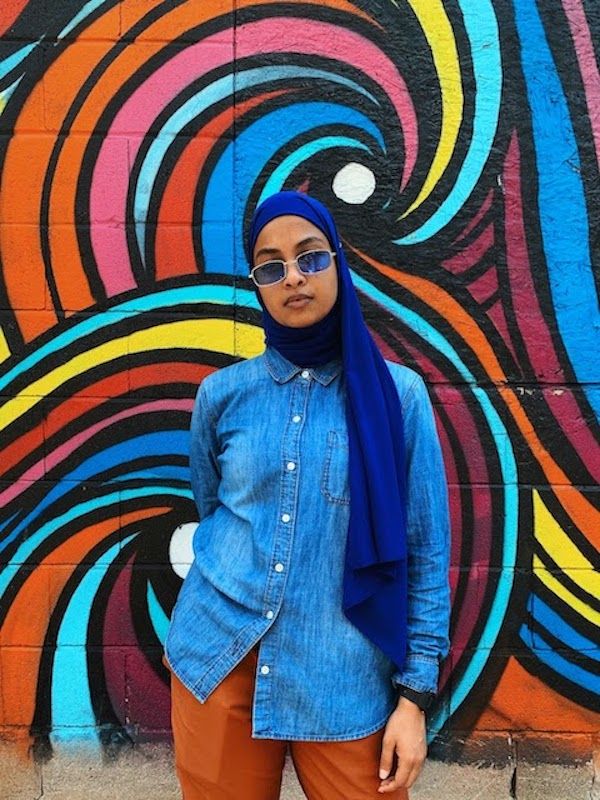Afeefah Haniff is empowering immigrant women through mural photography

By Shabna Rahman
A Canada-based Guyanese woman is on a mission to uplift other immigrant women who are struggling to cope with difficulties and make a difference in their lives, through the lens of her camera.
Afeefah Haniff, who found solace in having her photographs taken in front of vibrant and colourful murals and artwork in the streets of Toronto, saw an opportunity to help other women.
The mother of one, who has a passion for art, believed that the photography project could be an outlet for overcoming struggles and using the hashtag #coloredgirlsandcoloredwalls, began posting on Instagram, photographs of women of colour taken in front of murals that are relevant to their situations.
The project has strengthened her resolve to continue on the path of photojournalism, as she encourages the women to open up and share their stories. She has created a photography blog and website to share their empowering stories. Her husband, a photographer, has helped her to enhance her skills and build her website.
She pointed out that the project, which encourages community and a sense of celebration, has become a movement of “sharing our journeys of transgressing barriers while still embodying our truth and power.” It also provides an opportunity for the women to gain connections through support, comfort and representation.
Recognizing that women of colour do not always have a voice, she felt that creating a space for them to share their stories would help to break the trend and culture of silence. The project aims to “creatively own and celebrate our narrative… It also acts as a source of community. I want women to find confidence and comfort in sharing their stories and learning about others. I want women of colour to value and understand their worth and more importantly to always act their worth,” she said.

Interest in art
Haniff’s interest in art started from a young age as she created and designed some aspects of school projects while growing up in Guyana. She drew inspiration from her “surroundings, people, my religion, nature etc. As I grew and migrated, I started to cultivate a better understanding of the scope of this creative journey and began to embody creativity in all aspects of my life; illustrations, photography, fashion, makeup, lettering, poster designs, painting, writing, Arabic calligraphy etc. I truly enjoy nourishing the creative inside me and letting her grow.”
The #coloredgirlsandcoloredwalls began in 2017 but the actual transformation into a visual project began in 2020 through the creative portrait and interview sessions she conducted. Her journey on this path started right after she got married.
She related that she had placed a lot of pressure on herself, thinking that as a married woman, she had to be this perfect person. She also felt that she had to go out of her way to please everyone. It became overwhelming, but her husband assured her that “he married me for who I am” and that she did not need to change that.
To help her to cope with her stress, he started taking photos of her by murals that represented her struggles. She also found so much comfort and peace by just posing there, that she decided to get other women and girls involved.
She took the initiative to share her photos on Instagram, tagging her friends and motivating them to join in her journey.
“I’m feeling proud that now I can talk about [her struggles] and take a really good portrait of myself and be proud of how I overcame it,” she pointed out. “I see art as more than just drawing on paper or painting on canvas. I started seeing art in everything I did. Even when I started editing pictures, it was art for me. It was the way I de-stress.”
As she got down to helping the other women, she said, her pressing questions were: “How can I change their situations? How can I flip it to make it positive and help them to grow from it? That’s the whole intention. We want women to open up and speak about issues…”
“I would say that the first step is to let them know that they are not alone and they can change their story. And it doesn’t have to be what society says and the label that society puts on them; it doesn’t have to be that way forever…”

In the beginning when she started sharing the hashtag, she said, the project was “just silent and whoever wanted to do it would do it.” But as word started to spread on the social media platform, many women “saw the opportunity to open up and make it fun. It became encouraging for them and there were a lot of changes in their personal life afterwards,” she claimed.
A lot of the immigrant women from countries including Guyana, Jamaica, Pakistan and Bangladesh, experience difficulties like divorce, discrimination and racism. Having the opportunity to express themselves has been a healing process and a way of them finding their voices.
Haniff is grateful to her husband and an aunt, who raised her in Guyana, for recognizing the progress she made in coping with her own struggles, and for influencing her to get into mural photography.

Art shows
Her vision evolved to a portrait session of 18 women and girls for a virtual show last year, titled, The Colored Girls & Colored Walls.
“I was motivated to evolve it from being more than just a hashtag. I wanted it to be a project where I can offer my photography services as well,” she said.
It has also inspired her to make it bigger by creating a website to start blogging about the women’s stories. Haniff has also submitted her project to different art shows in Toronto. She hopes that later on, she can expand and participate in physical exhibitions.
The murals can be found on walls throughout Toronto, where the city pays artists to display their skills. Haniff and the women take advantage of the murals, which not only beautify the communities, but bring life to them.
She noted that her visual project has “a lot of depth,” as it reaches women who get demeaned easily when they are “harmed or shunned.” When that happens, “they internalise all of it and say they are the bad ones. We believe in our community and our society and so we go through this whole struggle and it is really difficult.”
She said that just “speaking about their struggles out loud” has helped the women to “change their narrative… and see their lives better and make positive changes.”
It is not only about negative stories though, but the positives as well. Haniff gave an example of a Jamaican woman who works as a news anchor, and chose a mural on a street called Jamaica Avenue, “to talk about reggae and the positive vibes she wanted to bring to the world.”

Empowering
For the women, the mural paintings are empowering. They have become an important form of expression, a representation of emancipation, as well as a symbol of solidarity, freedom and hope.
Haniff shares the map of the murals with the women “so they can choose online which one represents them… Whatever they choose, that’s where we’ll meet,” she said.
Covid-19 has restricted their meetings in groups, so she limits them to “not more than three persons per session.” She said, “When the world opens up I’ll share more. It’s definitely building an online community and I’ll see about the physical community later.”
One woman told her that having the opportunity to express herself during the photoshoot made it easier for her to talk to her family about an important matter that was affecting her. The woman was struggling to deal with her challenges by herself.
“It was emotional for some of the women” who finally found the courage to let go of some burdens they have been carrying on their shoulders for a long time, she said. “People have these negative stereotypes that if they go through something and it becomes public,” people would think less about them.
Stressing the seriousness of the struggle, the young mother said, “mental health is important and the first option should not be suicide…” She is happy that she is able to make an impact in her community and encourages more women to join in her cause.
[Reprinted with permission of the author; originally published in Stabroek News]
